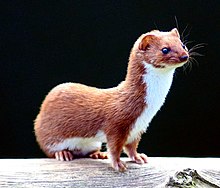
Back Wesel (dier) Afrikaans ትንሽ ፋደት Amharic Mustela nivalis AN ابن عرس صغير Arabic ابن عرس صغير ARZ Mustela nivalis AST Sikosiw ATJ Europaf Cigavol (Mustela nivalis) AVK Jisk'a achuqalla Aymara Adi gəlincik Azerbaijani
| Least weasel Temporal range: Late Pleistocene – Recent
| |
|---|---|

| |
| Least weasel at the British Wildlife Centre, Surrey, England | |
| Scientific classification | |
| Domain: | Eukaryota |
| Kingdom: | Animalia |
| Phylum: | Chordata |
| Class: | Mammalia |
| Order: | Carnivora |
| Family: | Mustelidae |
| Genus: | Mustela |
| Species: | M. nivalis
|
| Binomial name | |
| Mustela nivalis | |

| |
| Global range of the least weasel | |
The least weasel (Mustela nivalis), little weasel, common weasel, or simply weasel is the smallest member of the genus Mustela, family Mustelidae and order Carnivora.[2] It is native to Eurasia, North America and North Africa, and has been introduced to New Zealand, Malta, Crete, the Azores, and São Tomé. It is classified as least concern by the IUCN, due to its wide distribution and large population throughout the Northern Hemisphere.[1]
The least weasel varies greatly in size over its range. The body is slender and elongated, and the legs and tail are relatively short. The colour varies geographically, as does the pelage type and length of tail. The dorsal surface, flanks, limbs and tail of the animal are usually some shade of brown while the underparts are white. The line delineating the boundary between the two colours is usually straight. At high altitudes and in the northern part of its range, the coat becomes pure white in winter. Eighteen subspecies are recognised.
Small rodents form the largest part of the least weasel's diet, but it also kills and eats rabbits, other mammals, and occasionally birds, birds' eggs, fish and frogs. Males mark their territories with olfactory signals and have exclusive home ranges which may intersect with or include several female ranges. Least weasels use pre-existing holes to sleep, store food and raise their young. Breeding takes place in the spring and summer, and there is a single litter of about six kits which are reared exclusively by the female. Due to its small size and fierce nature, the least weasel plays an important part in the mythology and legend of various cultures.
- ^ a b McDonald, R.A.; Abramov, A.V.; Stubbe, M.; Herrero, J.; Maran, T.; Tikhonov, A.; Cavallini, P.; Kranz, A.; Giannatos, G.; Kryštufek, B.; Reid, F. (2019) [amended version of 2016 assessment]. "Mustela nivalis". IUCN Red List of Threatened Species. 2019: e.T70207409A147993366. doi:10.2305/IUCN.UK.2016-1.RLTS.T70207409A147993366.en. Retrieved 18 February 2022.
- ^ Valkenburgh, B.V.; Wayne, R.K. (2010). "Carnivores". Current Biology. 20 (21): R915–R919. doi:10.1016/j.cub.2010.09.013. ISSN 0960-9822. PMID 21056828.
